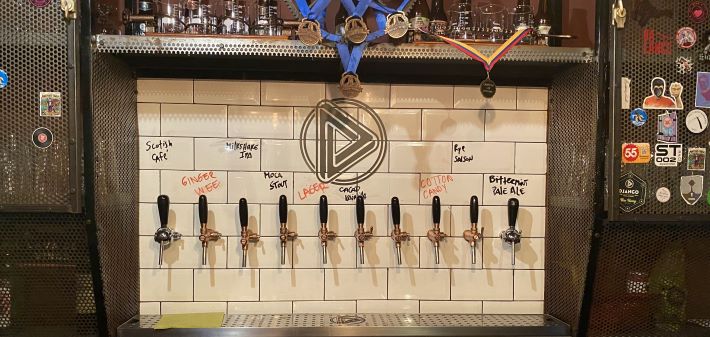
First, old business. Following up on “beer-flavored beer,” Jeff Alworth asks, “What Does Beer-Flavored Beer Taste Like?” Alan McLeod also expressed his opinion, in this case about “beer-flavoured beer.”
And now to new business, and the Beer Week That Was.
LEDE OF THE WEEK
Two weeks after Hurricane Helene destroyed most of his brewery, Jonathan Chassner sat on his back porch and sipped a warm coffee. He also had a lead on where to find a hot shower later that day. Both felt like a balm at a time when his family still didn’t have running water — potable or flushable — at their Asheville, North Carolina, home.
Despite the small comforts, Chassner’s thoughts drifted to beer, and to his ravaged business on the banks of the French Broad River. He founded Zillicoah Beer Company, located two miles northwest of downtown Asheville in Woodfin, North Carolina, with his brother, Jeremy Chassner, and partner Jonathan Parks in 2017. The three built much of it themselves, cutting concrete and finishing bathrooms. The work then turned to brewing beer, primarily lagers, on a relatively low-tech, hands-on system. The trio preferred it this way.
Chassner remembers precisely which beers were in his steel tanks when the storm hit: 465 gallons each of an applewood-smoked helles and a light, vibrant kellerpils. On Sept. 26, gallons and gallons of those beers merged with the same raging floodwaters that mangled the brewery’s fences and swept away its entire interior. Asheville’s water — coveted for its pristine, soft qualities — was the lifeblood of its celebrated brewing scene. With Helene, it became something Chassner could not have imagined: a destructive force. Two days later, when he was finally able to survey the damage from a high point 300 yards from the brewery, he struggled to recognize the scene in front of him.
— From Water fueled Asheville’s flourishing breweries. Then it ravaged them. (gift link)
QUOTE OF THE WEEK
“A lot of people here grew up knowing about chicha, with their aunt or grandmother making it. For many years, it had a stigma as a drink that was only for the lower classes living in the country. In Quito, as craft brewers became more knowledgeable about fermentation, they became more interested in reclaiming and revitalising this from their heritage.”
— Nathan Keffer in El Mitad del Mundo — Beer, Chicha, and the Intersections of Old and New in Quito, Ecuador
SOUND FAMILIAR? ‘CRAFT’ IS OUT, INDIE IS IN, GOLIATH IS THE ENEMY
There is plenty of repetition in these stories from Great Britain, but also something unique in each. In the order I came across them:
– Why small brewers are turning their back on craft beer
– Indie brewers tackle misleading globals
– Carlsberg juggernaut rolls over Banks’s
– How ‘big lager’ crushed Britain’s craft beer revolution
– The corporate takeover of ‘craft beer’ leaves a nasty taste in the mouth
YOU MIGHT ALSO ENJOY
– Stingo: A Day Trip to Baltimore for a Day Trip to Yorkshire. The Brewer’s Art is bringing a sixtel of the wood aged version of its Stingo to the Baltimore Craft Beer Festival on Saturday, November 2. “It is the last keg of the last Stingo made in the United States. It is not a whale, it is a unicorn. Make a day trip to Baltimore.”
– On Criticism in Beer Writing. More than 20 years ago I was in a brewery with Michael Jackson, where he was tasting through the lineup of what was available (fewer beers, thank goodness, than there would be today and certainly not 6 hazy IPAs). He asked detailed questions of the brewer, to the point I found it annoying because the next stop was dinner and I was hungry. When we left, he asked what I thought of the beers, and I said they tasted much like the water, which itself was not very good. He agreed. I asked why, in that case, he asked so many questions and took so many notes. He did not intend to write about this visit, he said, but he might return, the beers could be better and that was knowledge of value to him. Add your own moral to the story.
– And the Hall of Fame nominees are . . . Nineteen nominees for the American Craft Beer Hall of Fame have been announced. Six will be inducted in the Hall of Fame, that is if they receive 75 percent of votes cast by the Hall advisory board, as well as to the ACBHOF board of electors, which also consists of more than 50 people aligned with the craft beer industry.
– The Alewife-as-Witch Myth Revisited. “Brewing women were not viewed as inherently evil or caught up in evil magick. Nor were they believed to be witches simply because they took part in this trade.”
– How was beer different 15 years ago? ChurchKey in the District of Columbia turned 15 years old Saturday. Compare the taplist from 2009 to one now. “A few breweries from the 2009 opening have been bought: Flying Dog, by FX Matt/Saranac; Lagunitas, by Heineken; Avery and Founders, by Mahou; Otter Creek, by Harpoon; Stone by Asahi, Goose Island by AB InBev… but only one no longer exists in any form: Climax Nut Brown graced the opening taps, and that New Jersey brewery is now closed.”
– This week’s list you didn’t know you need. Every Voodoo Ranger IPA, tasted and ranked.